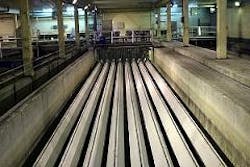Cloth Media Filter Eliminates Ongoing Maintenance and Performance Issues
Fox Metro Water Reclamation District (WRD) in Oswego, Ill., started up in the 1920s with a trickling filter system designed to treat an average daily flow of 8 MGD. Growth and new stringent effluent regulations during the 1960s and 1970s resulted in the installation of traveling bridge sand filters for tertiary filtration in the 1970s and conversion of the trickling filter system to an activated sludge treatment process in 1982.
Problem
The sand filters could not handle high flows in excess of 100 MGD (almost 20 percent more than the plant's rating) caused by rainfall, melting snow and high solids concentrations of 100 mg/L TSS or more produced by solids carryover from the secondary clarifiers. To solve its maintenance and performance issues, Fox Metro began researching other tertiary filtration technologies for a more effective alternative.
Solution
The AquaDiamond cloth media filter has a low profile and handles high solids-loading excursions better than the sand filters. Each cloth media filter tank provides 3.25 pounds TSS/ft2 per day of solids loading capacity. The cloth media filter costs less to install, operate and maintain over the life of the equipment as compared to sand filters. The lower costs are primarily due to a much smaller footprint, reduced building size and fewer components to install and maintain.
